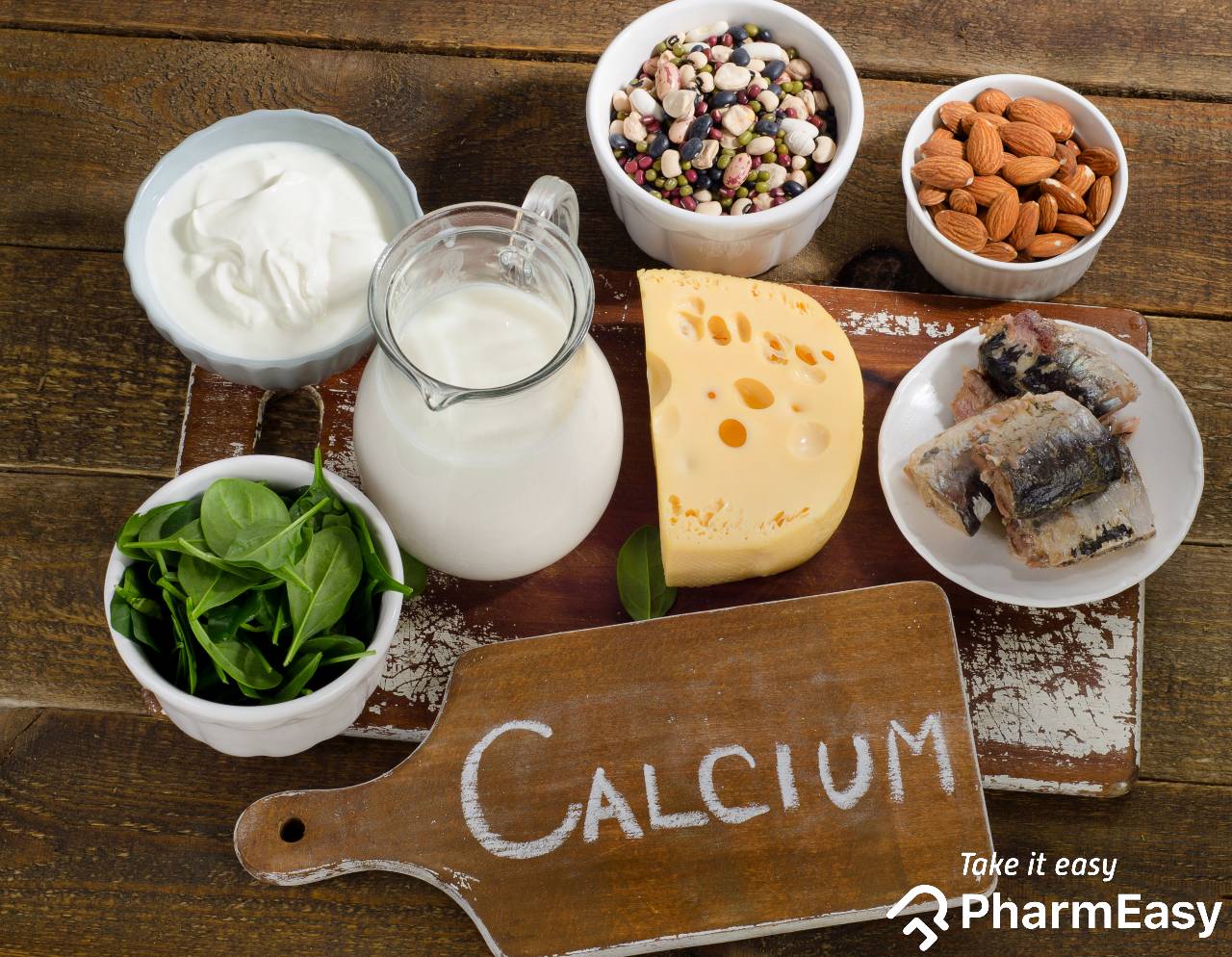Calcium-rich foods include dairy products, leafy greens, and fortified foods. Almonds, seeds, and sardines also provide high levels of calcium.
Understanding the importance of calcium-rich foods is crucial for maintaining strong bones and supporting vital bodily functions. Calcium is a crucial mineral necessary for bone health and plays a pivotal role in other physiological processes such as muscle function and nerve transmission.
Incorporating a variety of calcium sources into one's diet is essential, especially for individuals with specific dietary preferences or restrictions. By ensuring a diverse intake of calcium-rich foods, individuals can maintain optimal health and reduce the risk of developing conditions such as osteoporosis and bone fractures. It is essential to not only focus on the quantity but also the quality and absorption of dietary calcium to support overall well-being.

Credit: www.medicalnewstoday.com
Bone Health And Calcium's Role
Bone Health and Calcium's Role go hand in hand. Think of your bones as a bank where calcium is the currency. Your body makes frequent transactions with calcium to keep your bones strong. As you age, your bone density changes, making calcium even more crucial.
Why Calcium Matters For Bones
Your skeleton is the framework of your body, and it relies heavily on calcium. This mineral gives bones their strength and structure. Without enough calcium, bones can become weak and may break easily. Young or old, everyone needs calcium to maintain bone health.
- Bone growth: Children need it to develop strong bones.
- Bone repair: Adults need it to maintain and repair bones.
- Osteoporosis prevention: Adequate calcium intake may prevent this condition.
Daily Calcium Needs For Different Age Groups
Daily calcium intake varies depending on age, gender, and life stage. Below are the recommended amounts:
| Age Group | Daily Calcium Intake |
|---|---|
| Infants (0-6 months) | 200 mg |
| Children (1-3 years) | 700 mg |
| Adolescents (14-18 years) | 1,300 mg |
| Adults (19-50 years) | 1,000 mg |
| Seniors (Over 50) | 1,200 mg |
Tips: Dairy products, green leafy vegetables, and fortified foods are great calcium sources. Remember to pair calcium-rich foods with vitamin D for better absorption.
Dairy Delights Packed With Calcium
Did you know that dairy products are calcium superheroes? In the world of nutrition, dairy delights stand out for their impressive calcium content. This essential mineral helps build strong bones and teeth, making dairy products a must-have in your diet. Let's delve into the dairy aisle and discover the richness of calcium in these foods.
Milk And Its Nutrient Profile
Milk is not just a childhood favorite; it's a nutrient powerhouse. One cup of milk can offer about 300 mg of calcium, making it a significant source for your daily needs. But that's not all. Milk also comes loaded with vitamin D, protein, and potassium, which work together for better bone health. Here's a quick glance at what milk brings to the table:
| Nutrient | Amount per cup |
|---|---|
| Calcium | 300 mg |
| Vitamin D | Varies (fortified options available) |
| Protein | 8 g |
| Potassium | 380 mg |
Cheese Varieties And Their Calcium Content
When you think about cheese, think of calcium density. Different cheese varieties have different amounts of calcium. For instance, cheddar cheese boasts about 200 mg in a single ounce! Below, find a list of popular cheeses and their calcium contribution:
- Swiss Cheese: approximately 270 mg per ounce
- Feta Cheese: around 140 mg per ounce
- Mozzarella: close to 220 mg per ounce
- Parmesan: a whopping 330 mg per ounce
Remember, cheese is also a good source of protein and other nutrients. Enjoy it in moderation to reap the calcium benefits!
Plant-based Sources Of Calcium
Plant-based sources of calcium provide fantastic options for those following a vegan or dairy-free diet. Calcium is vital for bone health and muscle function. Many plants contain good amounts of this essential mineral. Let's dive into some plant heroes that are rich in calcium.
Leafy Greens: A Treasure Trove Of Calcium
Not all leafy greens are created equal when it comes to calcium content. Some greens pack a more powerful punch. Below are the stars in the leafy green category:
- Kale - This super green is not only rich in calcium but also vitamins A, C, and K.
- Collard Greens - A southern favorite, collards are great in stews and provide ample calcium.
- Turnip Greens - These greens have a peppery taste and are a hidden calcium gem.
Tip: Steaming these greens may increase the amount of calcium available for your body to absorb.
Nuts And Seeds With High Calcium
Nuts and seeds are not only tasty snacks but also little powerhouses of calcium. Packed with healthy fats and proteins, they make an excellent calcium addition. Here's a quick list:
| Nut/Seed | Calcium Content |
|---|---|
| Almonds | 76 mg per ounce |
| Chia Seeds | 179 mg per ounce |
| Sesame Seeds | 88 mg per tablespoon |
Add these to your diet by sprinkling them on salads, blending them into smoothies, or just snacking raw. Remember, moderation is key as nuts are calorie-dense.
Fish With Beneficial Bones
Did you know that some fish can be a powerhouse of calcium? The bones in these fish are soft and edible. They pack a punch with nutrients essential for bone health. Let's dive into two types of fish that are excellent for boosting your calcium intake.
Sub-section: Canned Salmon and Sardines for CalciumCanned Salmon And Sardines For Calcium
Canned salmon and sardines are champions when it comes to calcium-rich foods. Their bones are soft due to the canning process, making them easy to eat.
| Fish Type | Calcium Content |
|---|---|
| Canned Salmon (3 oz) | 181 mg |
| Sardines (3 oz) | 325 mg |
- Rich in omega-3 fatty acids.
- Includes vitamin D and protein.
Incorporating Fish Into Your Diet
Adding these fish to your meals is easy. Try these simple ways to get more calcium from fish.
- Flake canned salmon into salads.
- Mix sardines into pasta dishes.
- Create a sandwich spread with either fish.
Fortified Foods: A Modern Solution
Fortified foods leap modern nutrition into a new era. They tackle nutrient deficiencies with ease. Calcium is vital for strong bones and teeth. Finding it in foods is not always easy. Enter fortified foods. They are foods with extra nutrients added. This includes calcium. People with dietary restrictions find these options particularly helpful. Let's explore how fortified foods can boost your daily calcium intake.
Exploring Calcium-fortified Plant Milk
Plant milks are a favorite for many. They cater to lactose intolerance and vegan diets. But they lack calcium. Not anymore. Calcium-fortified plant milks change the game. They pack a punch of the nutrients into each serving. Almonds, soy, rice, and oats. All can be fortified with calcium. Almond milk and soy milk lead the pack. They often match or exceed the calcium in cow's milk.
- Fortified Almond Milk: 450 mg per cup
- Enriched Soy Milk: 300–450 mg per cup
Cereals And Juices With Added Calcium
Breakfast can be a calcium-rich meal. How? Through fortified cereals and juices. Your favorite morning cereals come with added calcium. One cup can offer up to 1000 mg of calcium. Orange juice is no slouch either. A glass of fortified orange juice can provide about 300 mg of calcium. It's a tasty way to start the day with a calcium kick.
Here's a snapshot of the calcium in these breakfast champions:
| Food Item | Calcium Content |
|---|---|
| Calcium-Fortified Cereal (1 cup) | 250 to 1000 mg |
| Calcium-fortified orange Juice (8 oz) | 300 mg |
Absorption Factors: Enhancing Calcium Uptake
The importance of calcium in supporting strong bones and teeth is well-known. Yet, the journey of calcium from your plate to your bones involves more than just eating calcium-rich foods. It's crucial to understand how your body absorbs calcium to ensure that you get the most out of the foods you eat. Let's unveil the factors that boost calcium uptake in the body.
The Role Of Vitamin D In Calcium Absorption
Vitamin D plays a key role in calcium absorption. Without adequate vitamin D, your body cannot absorb calcium effectively, no matter how much you consume. The sunshine vitamin, as it's often called, can be obtained from the sun, but food sources like fatty fish, eggs, and fortified products provide a reliable intake. Supplementing with vitamin D might be necessary for those with limited sun exposure or dietary intake.
Factors That Inhibit Calcium Absorption
Certain factors can hinder calcium absorption, thus weakening its benefits. These include:
- High sodium intake - Excessive salt causes more calcium to be excreted through the kidneys.
- Oxalates - Found in spinach, rhubarb, and beet greens, they bind to calcium and limit its absorption.
- Phytates - present in whole grains, legumes, and nuts, they can also lower calcium absorption.
- Caffeine and alcohol - Large amounts can interfere with the body's ability to absorb calcium.
Focus on balancing these inhibitors by pairing calcium-rich foods with absorption enhancers like vitamin D, and manage your intake of those substances that can lead to reduced calcium uptake.
Creating A Balanced Calcium-rich Diet
Creating a Balanced Calcium-Rich Diet is essential for maintaining strong bones and healthy bodily functions. Calcium is a vital mineral, playing a key role in supporting skeletal structure and enzyme functions. To ensure ample intake, incorporate various calcium-rich foods into every meal. Variety is the spice of life and diet too!
Combining Foods For Optimal Calcium Intake
An effective way to boost your calcium intake is by combining different food groups. This approach maximizes absorption and benefits. Pairing vitamin D-rich foods like salmon with calcium-packed greens can enhance calcium uptake. Consider these combos:
- Dairy and Vegetables: Yogurt with kale
- Fish and Grains: Canned sardines with whole-grain bread
- Fruit and Nuts: Figs with almonds
Calcium-rich Recipes For Daily Meals
Dive into delicious, calcium-rich recipes that can be enjoyed at different times of the day. Start with a fortifying breakfast, move to a satisfying lunch, and end with a hearty dinner. Remember to aim for variety!
Breakfast:
Cheesy Spinach Omelette:
- 2 eggs
- 1 cup spinach
- ¼ cup shredded cheddar cheese
Whisk together, cook on a skillet, and serve.
Lunch:
Broccoli and Chickpea Salad:
- 1 cup broccoli florets
- ½ cup chickpeas
- Feta cheese crumbles
Blend ingredients with your favorite dressing.
Dinner:
Sesame Tofu Stir-Fry:
- Cubed tofu, sauté in sesame oil
- Add mixed bell peppers and snap peas
- Garnish with sesame seeds and serve with brown rice

Credit: pharmeasy.in
Conclusion
Understanding the significance of calcium-rich foods is vital for maintaining strong bones and overall health. By integrating dairy products, leafy greens, and fortified foods into your diet, you're taking a crucial step towards a robust, nutrient-rich lifestyle. Remember, meeting your daily calcium needs is a journey worth prioritizing for your body's long-term well-being.


